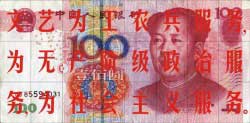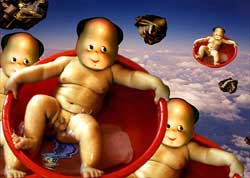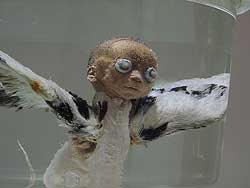Since the start of this month, police and propaganda officials in China have launched their biggest crackdown on Beijing’s counterculture hothouse – Dashanzi art district – where at least three galleries have been ordered to remove politically sensitive works, such as: a painting by Gao Qiang depicting Mao Zedong bathing in a Yangtze river the colour of blood; a child-like depiction of the 1989 Beijing massacre by Wu Wenjian; Huang Rui‘s cultural revolution slogan made up of banknotes bearing Mao’s portrait.
 Banknote by Huang Rui.
Banknote by Huang Rui.
Despite the crackdown, the Gao brothers said the climate was improving. From 1989 until 2003, they were on the government blacklist and forbidden to leave the country. But they are now part of a new wave of Chinese artists wowing galleries abroad. Next week, they will visit Nottingham to recreate their renowned work, Hug, in which they persuade strangers to embrace.

Painting by the Gao Brothers
Compared with the first years after he opened his gallery in 1990 (the first foreign-owned space for contemporary art in China), Brian Wallace says the atmosphere is improving. “Ten years ago the officials would have been rude and taken the pictures away. Now they are polite and ask for pictures to be withdrawn from public view.”

Image via Beausmith
Private and commercial freedom is almost unlimited, but anything public and political is subject to controls. Galleries in Dashanzi openly display nudity and sexually explicit pictures. But even a flat image of political leaders seems to make the censors queasy. One of the pieces that had to be removed is a grey painting of the current leadership all in the same dark suits and ties with the same hairstyle.
Talking about China, censorship and difference in culture, i’d just like to remind a story that made the headlines last year:
Berne’s Museum of Fine Arts had removed Xiao Yu’s sculpture made with the head of a dead fetus attached to a seagull’s body from a Chinese art exhibition last year after a complaint that it was disrespectful to the dead.

At the time, ethics experts, artists and art lovers argued that keeping the work under wraps was an affront to freedom of expression.
Shangaiist reports also about a Dalian factory that turns corpses into art. They have a “Corpse Exhibition” in Shanghai on April 28 after touring many major cities in China including Beijing, Guangzhou, Changsha and Shenyang.
Via The Guardian.
Related: The China Connection (part 2) – Transmediale.
